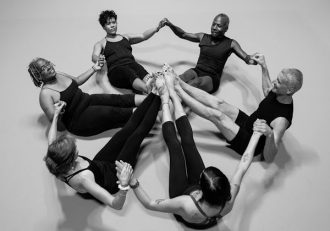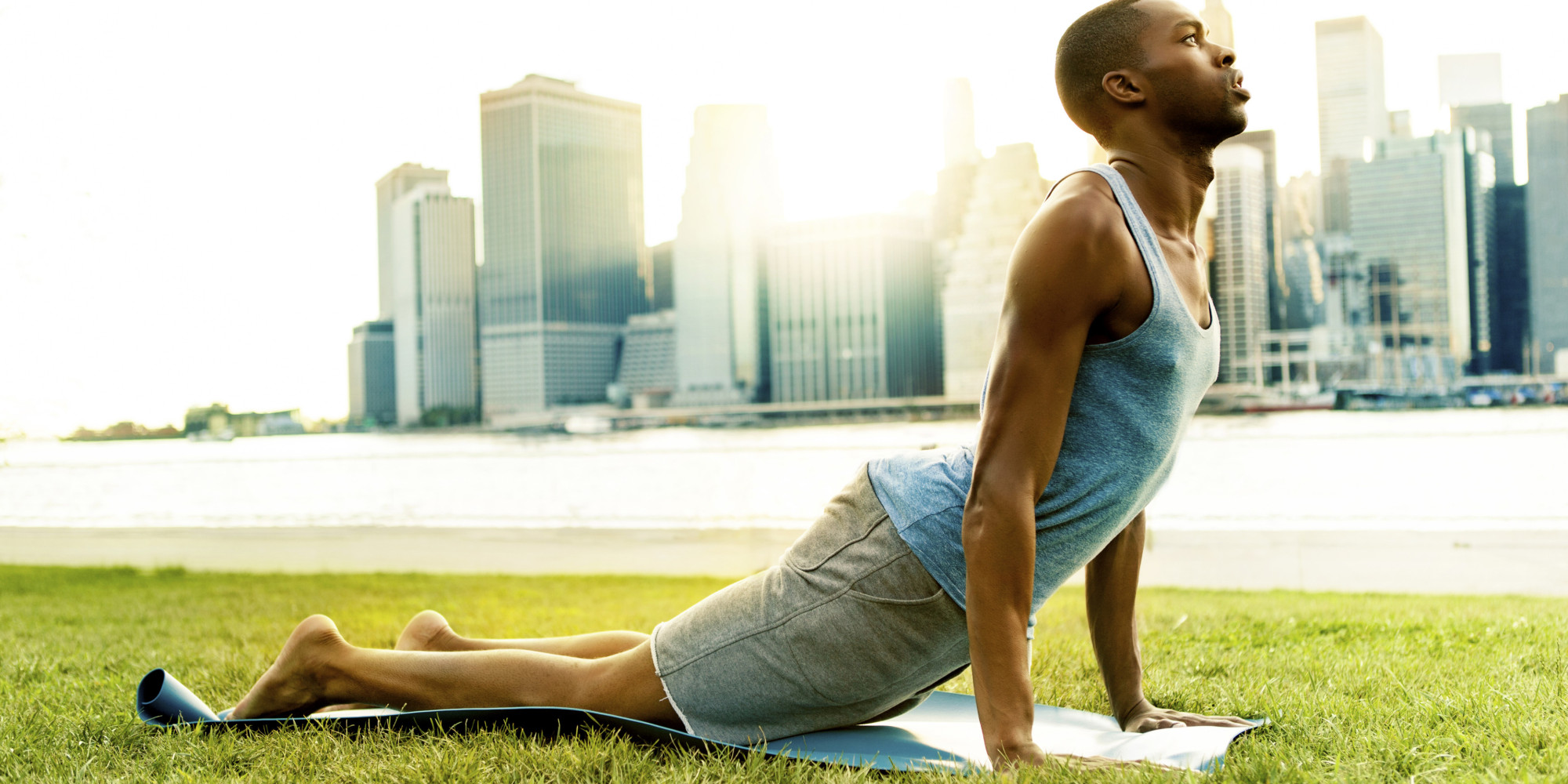Guest writer for Wake Up World
Yoga postures may not be something you’ve thought about for the purposes of improving your overall health and wellness. But research shows that even a daily, two-minute routine can strengthen core muscles throughout your body. Simple yoga moves can also improve your balance, increase your flexibility and even boost your mood. They can be tailored to every fitness level and come with advantages for your attitude and outlook, as well.
Performed daily or at least three days a week, slowly but surely you’ll find yourself becoming stronger, more flexible, and with a fresher outlook for your day. Special equipment is not a requirement. You need a few square feet of space and a mat, but don’t let that stop you from starting now. If you want, you can get that later.
Why Yoga in Addition to Basic Exercise?
One of the appeals of yoga is that it’s considered low impact, which means that it won’t jar your bones. It’s also excellent for relieving stress.
Men’s Fitness recently observed, quoting Sadie Nardini, host of Rock Your Yoga: “Along with training your body, yoga trains your mind to see the bigger picture and act from integrity instead of freaking out. If you want to be more James Bond than Charlie Sheen, get yourself on the mat.” 1
[pro_ad_display_adzone id=”110028″]
For increased flexibility, yogi, author and Ayurvedic practitioner Cameron Alborzian advises, “Think of the body as a sponge filled with dirty sink water. Gentle twists help to wring the sponge out and purge toxins.”
At the same time, you’re also lowering your heart disease risk, according to a joint Harvard School of Public Health and Netherlands Department of Radiology study.2 In the in-depth study, those involved in yoga showed significant improvement in body mass index and body weight, systolic and diastolic blood pressure, triglycerides and heart rate. In fact, researchers didn’t find any difference between the benefits of yoga and other types of exercise.
Research also indicates that yoga helps decrease chronic pain, fatigue and obesity, helping practitioners lose an average of 5 pounds. It may even help alleviate problems like irritable bowel syndrome and asthma.
Men’s Fitness recounted several other fringe benefits of practicing yoga, such as decreased workout or sports injuries, improved endurance for better sex, plus sculpted and strengthened muscles due to working muscle groups. Additionally, cleansing toxins helps you smell better. That’s always a plus.
Yoga Changes Your Brain
You heard that right. While helping people with stress, depression and anxiety, yoga is also noted for helping to literally change your brain for the better.
In 2015, one study3 used magnetic resonance imaging to compare the age-related changes in gray matter between regular yoga practitioners. In fact, as The Huffington Post reported:
“Yoga protects the brain from the decline in gray matter brain volume as we age. People with more yoga experience had brain volumes typical for much younger people. In other words, yoga could protect your brain from shrinking as you get older.”4
The left side, or hemisphere, of the brain protects your gray matter and increases brain volume. That’s the side of your brain that allows you to “feel” positive emotions such as joy and happiness.
The left hemisphere of your brain is also directly linked to your parasympathetic nervous system. Scientists call it the “rest and digest” network; it allows you to relax.
That brain-body connection isn’t just some psychologist’s idea of how the brain “probably” works: the physiological connection even shows up in positive emission tomography, aka PET scans, and brain imaging studies of people who meditate. According to The Huffington Post:
“In some regions of the brain, 50-year-old meditators were found to have the gray matter volume of 25-year-olds. These changes to the brain can occur within a few months. One study found brain changes after only eight weeks of a mindfulness-based stress reduction program. …
The regions of the brain responsible for learning, memory, cognition and emotional regulation showed growth. In contrast, the areas of the brain responsible for fear, anxiety and stress shrank.”5
[pro_ad_display_adzone id=”110030″]
Researchers working in a similar realm found neurological changes after only eight weeks of a mindfulness-based stress reduction program. Specifically, the magnetic resonance images (MRI) taken of the brains of 16 study participants (and 17 in a control group), who were completely uninformed regarding any positive or negative aspects of Mindfulness-Based Stress Reduction (MBSR), were tested before beginning and after finishing the program.
Not only did the gray matter of the group of 16 demonstrate increases in gray matter concentration in the left hippocampus, scientists examining the test confirmed that participants showed “ameliorate(d) symptoms of a number of disorders.” As written in the journal Psychiatry Research:
“The results suggest that participation in MBSR is associated with changes in gray matter concentration in brain regions involved in learning and memory processes, emotion regulation, self-referential processing and perspective taking.”6
Practicing Yoga to Change Your Mind
The way practicing yoga is able to change your brain, of course, is directly related to how it can change your mind, which are two separate issues. Men’s Fitness noted that:
“In the midst of a jam-packed schedule, committing to the relaxed space of a yoga class might be the only way for some guys to slow down and breathe right.
Scott Rodwin, founder of Radiance Yoga, explains that breathing exercises, called pranayama, have been developed over thousands of years to calm and tame that endless stream of thoughts.
This, he says, leads to greater concentration as you work your way through each pose — and, in most cases, a calmness that lasts the rest of the day.”
Benefits from yoga express themselves in ways you might not imagine. It doesn’t take long, though, for advantages to emerge, such as:
- Improved sleep — Even chronic insomnia, worsened by “psychological arousal” that keeps your mind spinning, is eased by practicing yoga, one study says.7
- Better brain function — Studies indicate that 20 minutes of Hatha yoga helps boost the speed and accuracy of mental processing better than the same amount of time spent in aerobic exercise, plus it lowers stress.8
- Reduced migraines — Just three months of yoga helped “significantly” reduce the number and severity of migraine headaches in 72 patients involved in a study on the effectiveness of yoga.9
- Diminished peripheral health problems — Researchers indicated that yoga can be helpful for conditions like chronic pain, epilepsy, depression, anxiety and post-traumatic stress disorder (PTSD) by increasing brain chemicals like gamma amino-butyric acid (GABA).10
The Huffington Post observed that from the time someone begins practicing yoga to getting into it a little more in-depth, their reasons for continuing it change.
“Two-thirds of yoga students and 85 percent of yoga teachers have a change of heart regarding why they do yoga — most often changing to spirituality or self-actualization, a sense of fulfilling their potential. Yoga offers self-reflection, the practice of kindness and self-compassion and continued growth and self-awareness.”11
As one yogi noted, “Yoga can change the heart — but we’re not just talking about blood pressure.”
A 2-Minute Yoga Routine
Personal trainer Jill Rodriguez demonstrates a simple, two-minute series of yoga poses, called asanas, in a video designed for you to start slowly. Practicing daily with special attention to your breathing, you’ll become more flexible over time.
• Child’s pose — Kneel with knees spread slightly, stretch your arms straight out to rest your palms on the mat in front of you, and lower your head between your elbows. Relax and stretch your back. Breathe slowly and deeply — in through the nose and out through the nose — five times. Then rise to a hands and knees position, palms flat to the mat directly under your shoulders and knees under your toes for the next stance.
• Cat-Cow — To loosen your hips and back, arch your back toward the ceiling, tucking your tailbone and chin inward. For the cow position, slowly raise your head while dropping your stomach toward the mat so that the small of your back is curved upward. Hold each position for five breaths.
• Downward-facing dog — Begin on hands and knees. Curl your toes under so you can slowly lift your knees off the mat to straighten your legs. Your hips are your highest point as your arms are outstretched and your body forms an inverted “V.” (When you’ve practiced this stance a few times, you can at this point slowly tighten the “V” formation, pushing your stomach toward your thighs.) Slowly begin lowering your heels to the mat behind you. Take your five deep breaths.
• Forward fold — Palms down on the mat, slowly bend your knees, lift your heels from the mat and walk your feet toward your hands. Keep your knees as bent as you need to (but with practice keeping them as straight as possible). Relax your arms; place them on your knees if you want, but continue the “folded” stance. Hold for five breaths.
• Warrior II — Stand, feet together, and take a wide step sideways. Point your right foot forward while your left foot is positioned to the left about 60 degrees. Facing front, hips and shoulders straight, bring your arms upward to shoulder height, palms down.
Bend your left knee so that your hips are balanced over your core, while straightening your right leg. Turn your heard so you’re looking over your left hand. Hold for five breaths. Shift your stance so that your feet are turned 60 degrees the other direction, and repeat, breathing at the end.
• The Mountain pose — This is how you want to end each session, to relax, arms loose at your sides, for another five breaths.
It’s best to be barefoot and wear light-weight, non-constricting clothes for this. You may also use either a yoga mat or the carpet of your living room floor.
Article Sources:
- 1 Men’s Fitness 2016
- 2 Eur J Prev Cardiol. 2016 February;23(3);291-307
- 3 Front Hum Neurosci. 2015 May 12;9:281
- 4, 5, 11 The Huffington Post July 10, 2016
- 6 Psychiatry Res. 2011 January 30;191(1):36-43
- 7 Appl Psychophysiol Biofeedback. 2004 December;29(4):269-78
- 8 Human Kinetics 2012
- 9 Headache. 2007 May;47(5);654-61
- 10 Medical-Hypothesis May 2012 Volume 78, Issue 5, Pgs. 571-579
Recommended articles by Dr. Mercola:
- Medical Errors: Still the Third Leading Cause of Death
- Battered Bees and the Threat to Our Food Supply
- The Biggest Cause of Anxiety and Depression is Traumatic Life Events
- Zika: Brazil Admits It’s Not the Virus
- Plants Are Smarter Than You Think
- The One Size Fits All Vaccination Schedule is Not Safe for Every Child
- Scientific Links Between Processed Foods and Depression
- How Sugar Harms Your Brain Health and Drives Alzheimer’s Epidemic
- The Health Benefits of Intermittent Fasting
- Can a Hug a Day Keep Infection Away?
- Fluoride Deception Continues: US Government Ignores Fluoride’s Role as an Endocrine Disruptor
- The Magic Healing Power of Mushrooms
- The Science of Healing Thoughts
About the author:
 Born and raised in the inner city of Chicago, IL, Dr. Joseph Mercola is an osteopathic physician trained in both traditional and natural medicine. Board-certified in family medicine, Dr. Mercola served as the chairman of the family medicine department at St. Alexius Medical Center for five years, and in 2012 was granted fellowship status by the American College of Nutrition (ACN).
Born and raised in the inner city of Chicago, IL, Dr. Joseph Mercola is an osteopathic physician trained in both traditional and natural medicine. Board-certified in family medicine, Dr. Mercola served as the chairman of the family medicine department at St. Alexius Medical Center for five years, and in 2012 was granted fellowship status by the American College of Nutrition (ACN).
While in practice in the late 80s, Dr. Mercola realized the drugs he was prescribing to chronically ill patients were not working. By the early 90s, he began exploring the world of natural medicine, and soon changed the way he practiced medicine.
In 1997 Dr. Mercola founded Mercola.com, which is now routinely among the top 10 health sites on the internet. His passion is to transform the traditional medical paradigm in the United States. “The existing medical establishment is responsible for killing and permanently injuring millions of Americans… You want practical health solutions without the hype, and that’s what I offer.”
Visit Mercola.com for more information, or read Dr. Mercola’s full bio and résumé here.
[pro_ad_display_adzone id=”110027″]








